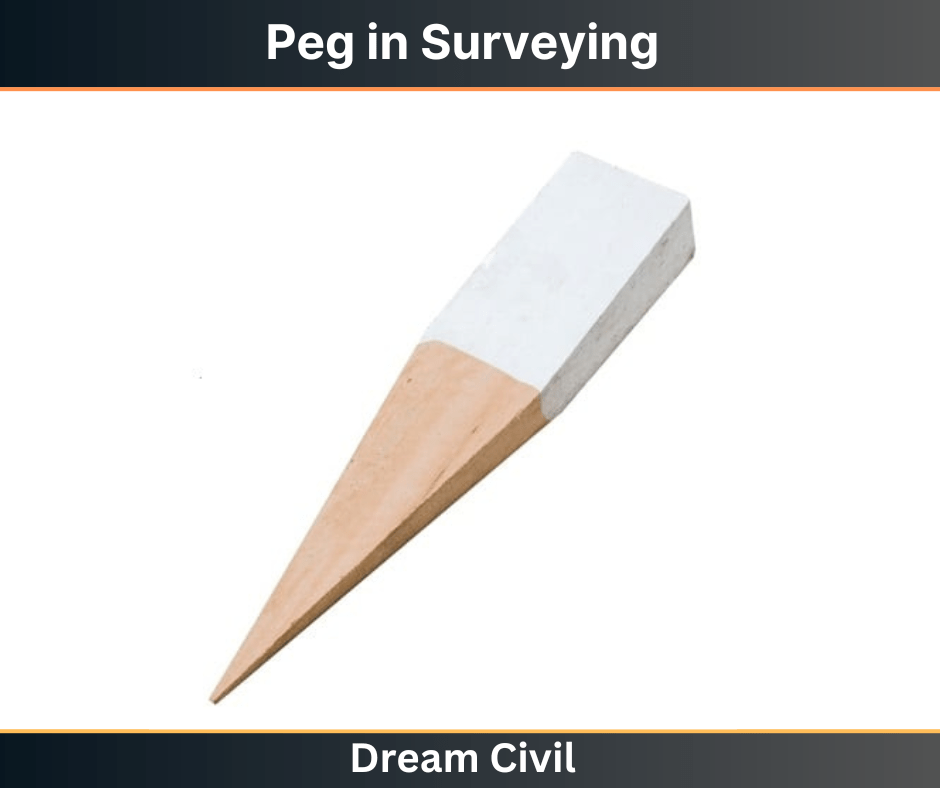Table of Contents
Peg in surveying is a short pin or bolt-type structure made up of wood or metal or plastic which is tapered at its one end to secure it in the desired point or station.
Generally, the peg of a square-shaped base is used. Its side may range between 20 mm to 30 mm. Commonly used length of the peg is 150 mm. About 40 mm part of Peg is left above the ground while installing it in location.
Peg in surveying is also known as survey peg or survey stakes or survey marking stakes.

Fig: Wooden Peg
Survey pegs are used for marking the points and boundaries of the residential or industrial site.
Due to the pointed ends of the peg, it can be easily installed on the ground. Wooden pegs are cheap and commonly used pegs in surveying.
1. Importance of Peg in Surveying
Some of the importance of pegs are:
a. In surveying, the peg is very important to separate the boundaries.
b. Peg helps in marking or locating the stations or points on the ground.
c. Different color codes can be given to different pegs for increasing the surveying rate. (E.g. Using red-colored pegs for marking boundaries and using blue-colored pegs for marking interior details.)
2. Uses of Peg in Surveying
Some uses of peg are:
a. Used for fixing or marking the road alignments.
b. Used for marking the boundaries of the land to be surveyed.
c. Used for separating the boundaries of the properties.
d. While transferring the point into the ground from surveying instruments( In the plane table surveying, leveling, etc); pegs are used as a marking element.
3. Types of Peg in Surveying
Peg in surveying can be classified into two types based on function and material.
a. Based on Function
Pegs based on their function in surveying are:
a. Indicator Survey peg
~ The top portion of this peg is white-colored.
~ Other colors also can be allowed based on the demand of the client.
~ It is a little pointed at one end and is commonly made from hardwood.
~ Its tapered end (end to be secured into the ground) is blunt and looks like a pencil. The opposite end is generally square in shape.
b. Boundary survey peg
~ Boundary survey peg is installed by surveyors on legal land to distinguish the boundary between two assets.
~ This kind of peg is so often used in sites for sub-division of lands.
~ It is a short type peg with one end pointed and the upper part to be left above the ground is painted containing chamfer.
c. Dumpies survey peg
~ Dumpies peg is used for accurate positioning of assets.
~This is made up of hardwood timber and can be painted or unpainted based on choice and demand.
d. Residential Survey peg
~ This peg can differ in its length and is painted white in color. It is used to symbolize the absolute location or area selected for residential purposes.
b. Based on Materials
Peg can be made up of hard timber, and metals like iron, steel, etc. Materials used for making pegs in surveying must be strong and good in quality.
There are 3 types of peg based on materials. They are:
1. Timber peg
~ The peg that is made from timber is a timber peg.
~ Mostly surveyors use hardwood timber to make pegs.
~ This peg is used in most countries as the priority.
2. Metal peg
~ The peg that is made by utilizing metals is a metal peg.
~ Metals like steel or iron can be used to make pegs.
~ Steel or iron pegs should be stainless, non-rusting, thermally resistant to exposure to sunlight, humidity resistant, etc.
~ Some pegs use steel only at their top part.
3. Plastic Peg
~ The peg that is made using plastic is a plastic peg.
~ Generally bakelite-type plastic is used for making pegs.
~ It is durable and non-corrosive. So, mostly used in important projects & surveys.
c. Based on Shape
Based on the shape of the peg; it can be classified into 3 types.
a. Rectangular Peg
If the non-tapered end of the peg is rectangular in shape then it is a rectangular peg. Its body is cuboidal.
b. Square Peg
If the non-tapered end of the peg is square in shape then it is a square peg. Its body is cuboidal.
c. Circular Peg
If the non-tapered end of the peg is circular then it is a circular peg. Its body is cylindrical.
Read More: Line Ranger in Surveying

